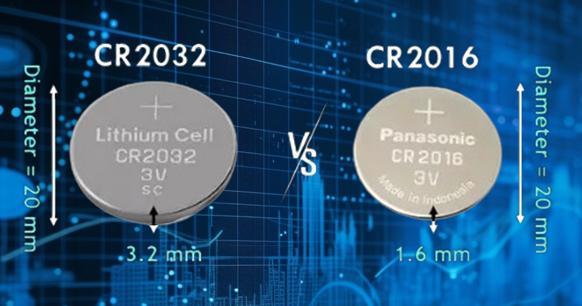
CR2016 vs CR2032: Choosing the Right Button Battery for Your Device

In conclusion, while both CR2016 and CR2032 batteries are rated at 3V, their varying power capacities illustrate the importance of exercising caution when replacing them. As with AA dry batteries, understanding the relationship between voltage, capacity, and size is essential for optimizing performance in a range of electronic devices. Consequently, an understanding of the specifics of these lithium button batteries enables customers to make informed decisions based on the requirements of their devices.
|
Feature |
CR2016 |
CR2032 |
|
Cell Size |
Diameter: 20mm, Height: 1.6mm |
Diameter: 20mm, Height: 3.2mm |
|
Nominal Voltage |
3V |
3V |
|
Capacity |
75mAh |
220mAh |
|
Applications |
Watches, calculators, devices with lower power consumption |
Medical devices, slightly more power-hungry electronics |
|
Usage Suitability |
Low-power devices |
Low to medium-power devices |
|
Dimensions |
Smaller diameter, 16mm |
Standard diameter, 20mm |
|
Price |
Generally lower due to lower capacity |
Typically higher due to higher capacity |
CR2016 vs. CR2032: Thinkness
There are notable differences between CR2016 and CR2032 button batteries that extend beyond mere nomenclature. In essence, the numerical values in their nomenclature indicate their dimensions. Both are 20 mm in width, but the pivotal distinction is in their thickness. The CR2016 is a slim 1.6 mm in width, while the CR2032 is a thicker 3.2 mm. While both batteries provide 3V of power, the thickness is a significant factor in determining their power holding capacity and longevity.
CR2016 vs. CR2032: Capacity
As a general rule, a thicker battery can accommodate a greater amount of power. This is applicable to all batteries of the same type. The underlying concept is straightforward: batteries with greater thickness offer enhanced power capabilities, resulting in extended operational longevity. If your device is compatible with a thicker battery, it may offer a more durable power source.
CR2016 vs. CR2032: Weight
The weights of these batteries vary noticeably. Specifically, the typical weight for a CR2032 is 3.1g, while a CR2016 averages 1.6g.
CR2016 vs. CR2032: Applications
It is important to consider the specific applications of the CR2016 and CR2032 when making a comparison. The CR2032 is a common component in electronic dictionaries, while the CR2016 is used extensively in electronic watches.
To provide further technical specifications, the CR2016 operates at 3V with a power capacity of approximately 75mAh. In comparison, the CR2032 is thicker but still provides 3V and can hold approximately 200mAh of power. The primary distinction in power output is due to the thickness of the batteries. The CR2032 is approximately twice as thick as the CR2016.
Can one CR2032 replace two CR2016 batteries?
It is inadvisable to attempt to use two CR2016 batteries in succession to replace a CR2032. Connecting them in this manner results in an output voltage of 6V, which is incompatible with devices designed for a single 3V CR2032.
However, there is another possible solution. The connection of two CR2016 batteries in parallel can serve as a substitute for a CR2032. This maintains a power output of 3V, theoretically providing a combined power of 150mAh. It is important to note that this configuration provides less power than a single CR2032, with the output being approximately three-quarters of the capacity of a single CR2032. Additionally, the necessity of two battery slots renders this solution somewhat complex.
CR2016 vs. CR2032: Similarities Between CR2016 and CR2032
|
Feature |
CR2016 |
CR2032 |
|
Shared Materials |
Positive electrode: Manganese dioxide; Negative electrode: Metallic lithium; Electrolyte: Lithium battery electrolyte with lithium perchlorate; Solvent components: Propylene carbonate (PC), Dimethyl carbonate (DMC), Dioxolane (DOL) |
Positive electrode: Manganese dioxide; Negative electrode: Metallic lithium; Electrolyte: Lithium battery electrolyte with lithium perchlorate; Solvent components: Propylene carbonate (PC), Dimethyl carbonate (DMC), Dioxolane (DOL) |
|
Similar Shape |
Cylindrical |
Cylindrical |
|
Matching Diameters |
Diameter: 20mm |
Diameter: 20mm |
|
Uniform Voltage Levels |
Nominal voltage: 3.0V; End voltage: 2.0V |
Nominal voltage: 3.0V; End voltage: 2.0V |
|
Identical Operating Temperature Range |
-20℃ to 60℃ (Practical usage typically between 5℃ to 60℃) |
-20℃ to 60℃ (Practical usage typically between 5℃ to 60℃; Some BR series batteries have extended range of -50℃ to 125℃, not explored in detail within this CR series discussion) |
|
Uniform Storage Environment |
Temperature: ~20℃; RH <75% |
Temperature: ~20℃; RH <75% |
Shared Materials: Both CR2016 and CR2032 utilise identical materials. The positive electrode employs manganese dioxide, renowned for its exceptional chemical stability, while the negative electrode relies on metallic lithium. The electrolyte is composed of lithium battery electrolyte, primarily comprising lithium perchlorate, with propylene carbonate (PC), dimethyl carbonate (DMC), and dioxolane (DOL) serving as the solvent components.
Similar Shape: Both batteries are cylindrical in shape.
Matching Diameters: The diameters are aligned, falling into two distinct groups: 20mm and 16mm, respectively.
Uniform Voltage Levels: Both batteries are equipped with the same voltage specifications, offering a nominal voltage of 3.0V and an end voltage of 2.0V.
Identical Operating Temperature Range: Both the CR2016 and CR2032 batteries have a consistent operating temperature range of -20°C to 60°C. However, the practical usage range typically falls between 5°C and 60°C. It is worth noting that some manufacturers of BR series wide-temperature batteries have achieved an extended range of -50°C to 125°C, although this is not explored in detail within the scope of this CR series discussion.
Uniform Storage Environment: It is recommended that both batteries be stored in an environment with an approximate temperature of 20°C and relative humidity (RH) below 75%.
In conclusion, the comparison between CR2016 and CR2032 highlights the subtle differences that determine their suitability for various electronic devices. While these button batteries share certain similarities, such as their compact dimensions and coin-like appearance, their divergent specifications make them distinct entities. Understanding the differences between these products, whether in diameter, thickness, or voltage, allows consumers to make informed choices based on the specific requirements of their devices.




